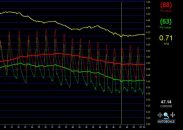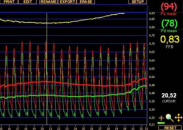Original Title: Left main stenting in Comparison with Surgical Revascularization 10-year outcomes of the (Left Main Coronary Stenting) LE MANS trial. Reference: Buszman P et al. J Am CollCardiolIntv. 2016;9(4):318-327. doi:10.1016/j.jcin.2015.10.044. Courtesy of Dr. Guillermo Migliaro. Long term outcomes of left main stenting are unknown. This study reports 10 year follow up outcomes of the LEMANS trial patients. The…
Impact of the Right Atrial Pressure on FFR measurement
Original Title: Impact of the Right Atrial Pressure on Fractional Flow Reserve Measurements Comparison of Fractional flow Reserve and Myocardial Fractional flow Reserve in 1600 Coronary Stenosis. Reference: Toth G, et al. JACC Cardiovasc Interv. 2016 Feb 12. Epub ahead of print. Courtesy of Dr. Guillermo Migliaro. Fractional Flow Reserve (FFR) is the gold standard for the…
Should ranolazine be considered for all incomplete revascularization patients?
Original Title: Effects of Ranolazine in Angina and Quality of Life after Percutaneous Coronary Intervention with Incomplete Revascularization Results from the Ranolazine for Incomplete Vessel Revascularization (RIVER-PCI) Trial. Reference: Karen P. Alexander et al. Circulation. 2016 Jan 5;133(1):39-47 Courtesy of Dr. Santiago Alonso Persistence or return of angina after PCI is relatively frequent, which is why…
Diabetes has higher impact on DES outcomes than disease complexity
Original Title: Impact of diabetic status on outcomes after revascularization with drug-eluting stents in relation to coronary artery disease complexity. Reference: Koskinas KC et al. Circ Cardiovasc Intv. 2016; Epub ahead of print Diabetic patients ongoing PCI with drug eluting stents (DES) are at higher risk of repeat revascularization than non-diabetic patients. According to this…
FFR in non-ST elevation myocardial infarction
Original Title: Fractional flow reserve vs. angiography in guiding management to optimize outcomes in non-St segment elevation myocardial infarction: the British Heart Foundation FAMOUS–NSTEMI randomized trial. Reference: Jamie Layland et al. European Heart Journal (2015) 36, 100–111 Courtesy of Dr. José Amadeo Guillermo Álvarez. Several studies have established the value of fractional flow reserve (FFR) in…
Incomplete Revascularization in the Long Term
Original Title: Long-Term Outcome of Incomplete Revascularization after Percutaneous Coronary Intervention in SCAAR (Swedish Coronary Angiography and Angioplasty Registry). Reference: Kristina Hambraeus et al. J Am Coll Cardiol Intv. 2016;9(3):207-215. The aim of this study was to describe the evolution of patients with multivessel disease undergoing PCI with incomplete revascularization, and its probable association to…
SORT OUT IV at 5 years: second generation DES efficacy confirmed
Original Title: Safety and efficacy of everolimus-versus sirolimus-eluting stents: 5-Year results from SORT OUT IV. Reference: Jensen LO et al. J Am Coll Cardiol. 2016;67:751-762. Reassuring long term outcomes from SORT OUT IV confirm the safety and efficacy of second generation everolimus eluting stents (EES) over first generation DES. The difference at 5-year follow up…
Primary PCI with Bioresorbable Vascular Scaffolds
Original Title: One-year Clinical and Computed Tomography Angiographic Outcomes after Bioresorbable Vascular Scaffold Implantation during Primary Percutaneous Coronary Intervention for ST-Segment-Elevation Myocardial Infarction. The Prague-19 Study. Reference: Widimsky P et al. Circ Cardiovasc Interv. 2015 Dec;8(12). Courtesy of Dr. Carlos Fava. Primary PCI is the most common course of treatment for ST elevation myocardial infarction (STEMI)…
In saphenous vein graft lesions, 1st and 2nd generation DES have similar outcomes
Long-Term Outcomes with First vs. Second-Generation Drug-Eluting Stents in Saphenous Vein Graft Lesions. Nagendra R. Pokala. Catheterization and cardiovascular Intervention 2016;87:34-40 Courtesy of del Dr. Carlos Fava. Second generation DES have been proved superior to first generation DES in native arteries, but there is limited information on DES in saphenous vein grafts (SVG), from a…
Drug eluting balloon vs. second generation DES for restenotic lesions in bifurcations
Original Title: Drug-eluting balloon versus second-generation drug-eluting stent for the treatment of restenotic lesions involving coronary bifurcations. Reference: Toru Naganuma et al. EuroIntervention 2016;11:989-995 Courtesy of del Dr. Santiago F. Coroleu. PCI involving in-stent restenosis (ISR), especially in coronary bifurcations, is associated with high rates of recurrent restenosis and the need for new revascularization. Although drug…
Cutoff FFR Values, What to Do in the “Grey Zone”
Original Title: Significance of Intermediate Values of Fractional Flow Reserve in Patients with Coronary Artery Disease. Reference: Julien Adjedj et al. Circulation. 2016 Jan 5. Epub ahead of print. The fractional flow reserve (FFR) value of 0.75 has been validated against tests for inducible ischemia, whereas the value 0.80 has been widely accepted to guide the…










